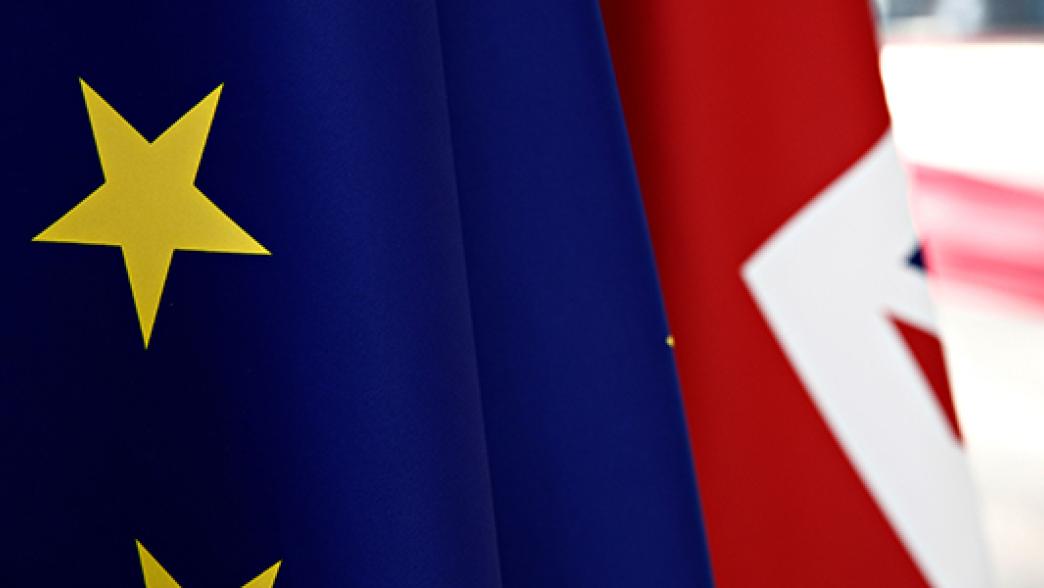UK–EU future relationship: association agreements
The possibility of a UK–EU association agreement after Brexit has been suggested. But what does that actually mean?

What is an association agreement?
An association agreement is a treaty between the European Union and a non-EU country that creates a framework for co-operation between them. Its legal basis is defined in Article 217 of the Treaty of the Functioning of the EU (TFEU), which provides for “an association involving reciprocal rights and obligations, common action and special procedures”.
The EU has more than 20 association agreements, mainly with its neighbours, from Morocco to Ukraine.
Why does the EU have association agreements?
The EU uses an association agreement to create “privileged links” with a third country. This can involve setting up a free trade area or creating broader economic and political co-operation in areas of mutual interest – for example, on defence and security, migration, environmental protection and energy, science, and education.
The EU originally came up with association agreements to prepare non-member countries for accession. The very first such agreement was signed by Greece in 1961. But the EU has since used these agreements to improve trade with non-member countries such as Morocco but also to develop deeper, long-term political relations with neighbouring countries like Ukraine.
The EU also has special types of association agreements including ‘stabilisation and association agreements’ with Western Balkan countries and a so-called ‘Deep and Comprehensive Free Trade Area’ (DCFTA) with Ukraine, Georgia and Moldova.
Could the UK and EU have an association agreement after Brexit?
It is too early to tell.
The EU Commission has recommended using Article 218 as the legal basis for its negotiations on the future relationship with the UK (which the EU used for trade negotiations with Canada and also Singapore).
However, the EU's draft mandate for UK–EU future relationship negotiations, which was published on 3 February 2020, also mentions Article 217 as a potential legal basis. The scope of the agreement will determine which legal basis the EU chooses.
The European Parliament’s March 2018 resolution on the future UK–EU relationship recommended using an association agreement as a model for the future relationship with the UK. It stressed the advantages of an association agreement’s flexible framework, which would allow for “varying degrees of co-operation across a wide variety of policy areas”, which is desired by both parties.
An association agreement was also hinted in both the European Council draft guidelines and the European Parliament's previous Brexit resolution on 5 April 2017. Having an UK–EU association agreement has been also discussed in reports from the House of Lords European Exit Committee and the European Parliament’s Constitutional Affairs Committee.
What are the rights and obligations that come with an association agreement?
Most rights and obligations that come with an association agreement arise from the exact content of an individual agreement. However, Article 217 states three main criteria for an association agreement:
- The agreement must create privileged links between the EU and non-EU country that aim to foster wide-ranging co-operation between them.
- Both the EU and a third country must have reciprocal rights and obligations in their partnership.
- The agreement creates institutions designed to implement and monitor the agreement, such as an Association Council (ministerial-level group) and an Association Committee.
In addition to these broad principles, association agreements are typically characterised by four other features:
- They contain a free trade agreement with the EU. But these free trade agreements tend to vary country by country.
- In return for some access to the single market, a non-EU country is often required to share part of relevant EU regulations – so-called EU acquis.
- They create opportunities to co-operate beyond trade in areas of mutual interest, from defence and security, to environment and energy, to science and education.
- They include a clause on the respect of human rights and democratic principles.
How easy is it to agree an association agreement?
That depends on the exact content of an agreement, and political buy-in from all EU member states.
Associations agreements require unanimity in the European Council. More generally, association agreements are so-called ‘mixed agreements’ – agreements that fall under both EU and member state competence. That means they must be ratified by the European Parliament, Council of the EU, and all 27 member states.
The process follows the national procedures for ratification of international agreements, including regional parliaments where that is required.
This puts an association agreement in the same category as a comprehensive trade deal like the EU free trade agreement with Canada (CETA), which took seven years to negotiate.
Would an association agreement make it easier to negotiate the UK’s future relationship with the EU?
One practical advantage is that it provides a ready legal framework, which could shorten the time necessary for legal drafting of a comprehensive agreement between the UK and EU. Much of the technical legal drafting could be carried over from the EU’s existing agreements if a similar structure was adopted.
However, the substance would still be for negotiation, and an association agreement still requires the same ratification process as any other ‘mixed agreement’ – including unanimity in the European Council.